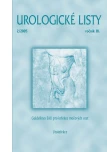The principles of antimicrobial treatment in uroinfections
Authors:
A. Ševčíková; P. Ševčík
Authors‘ workplace:
Anesteziologicko-resuscitační klinika LF MU a FN u sv. Anny v Brně
; Oddělení klinické mikrobiologieLF MU a FN Brno
Published in:
Urol List 2005; 3(2): 5-12
Overview
Alongside the upper respiratory infections, the urinary tract infections (UTI) are the second of the most frequent infectuous diseases in population. Their incidence is changing dependent on age and sex. The majority of non-complicated lower urinary infections is well curable, nevertheless, the increasing resistance to antibiotics complicates the treatment of reccurent infections, complicated cystitis and pyelonephritis. It becomes a big problem at nosocomial infections. The authors recount the pathophysiology, ethiology and diagnostic methods of urinary tract infections (UTI). In the conclusion they give an overview of general principles of their antibacterial treatment.
KEY WORDS:
urinary tract infections, uropathogenous bacteria, antibacterial drugs, antibiotics
Sources
1. Teplan V. Úvod do problematiky. In: Teplan V, Horáčková M, Bébrová E, Janda J et al. Infekce ledvin a močových cest. Praha: Grada Publishing 2004: 15-16.
2. Bartoníčková K. Uroinfekce. Praha: Galén 2000; 8. vol.
3. Alvarez-Rocha L, Rascado-Sedes P, Castro-Orjales MJ. Urinary tract infections. In: Rello J, Valles J, Kollef M (eds). Boston Critical Care Infectious Diseases. Boston: Kluwer Academic Publishers 2001: 731-748.
4. Bébrová E. Mikrobiologické aspekty patogeneze infekcí močových cest. In: Teplan V, Horáčková M, Bébrová E, Janda J et al. Infekce ledvin a močových cest. Praha: Grada Publishing 2004: 31-44.
5. Kantele A, Möttönen T, Ala-Kaila K, Arvilommi HSP. Fimbria-specific B cell responses in patients with urinary tract infection. J Infect Dis 2003; 188:1885-1891.
6. Votava M. Lékařská mikrobiologie obecná. 1. ed. Brno: Hortus 2000.
7. Förstl M, Kolářová L, Veselský Z, Macek P, Dvořák P. Schistosomóza (Bilharzióza) močového traktu. Urologie pro praxi 2003; 4(1): 8-10.
8. Förstl M, Kolářová L, Konštacký M, Veselský Z, Macek P, Dvořák P. Riziko importu schistosomózy (bilharziózy). Interní medicína pro praxi 2003; 5(2): 57-60.
9. Bébrová E. Bakteriologická diagnostika infekce močových cest, racionální léčba antibiotiky a chemoterapeutiky. In: Teplan V, Horáčková M, Bébrová E, Janda J et al. Infekce ledvin a močových cest. Praha: Grada 2004: 45-62.
10. Alves LS, Assis BP, Rezende MM. Schistosomal epididymitidis. Int Braz J Urol. 2004; 30: 413-415.
11. Kolář M. Klinicko-mikrobiologické podklady racionální antibiotické léčby. Praha: Trios 2002.
12. Wagenlehner FM, Naber KG. Antibiotic treatment for urinary tract infections: pharmacokinetic/pharmacodynamic principles. Expert Rev Anti Infect Ther 2004; 2: 923-931.
13. Urbánková P. Pracovní skupina pro monitorování rezistence NRL pro antibiotika. Rezistence nejčastějších původců komunitních močových infekcí v ČR v roce 2001.
14. Lacombe K, Cariou S, Tilleul P, Offenstadt G, Meynard JL. Optimizing fluoroquinolone utilization in a public hospital: a prospective study of educational intervention. Eur J Clin Microbiol Infect Dis 2005; 24(1): 6-11.
15. Hooton TM, Besser R, Foxman B, Fritsche TR, Nicolle LE. Acute Uncomplicated Cystitis in an Era of Increasing Antibiotic Resistance: A Proposed Approach to Empirical Therapy. Clin Infect Dis 2004; 39: 75-80.
16. Hummers-Pradier E, Ohse AM, Koch M, Heizmann WR, Kochen M. Urinary tract infection in men. Int J Clin Pharmacol Ther 2004; 42: 360-6.
17. Members of the UTI Working Group EAU. Guidelines for the Management of Urinary and Male Genital Tract Infections. Eur Urol 2001; 40: 576-588.
18. Members of the ECLM and ESMID Working Party. Articles European Urinalysis Guidelines: Summary. Scand J Clin Lab Incest 2000; 60(4 Suppl): 231.
Labels
Paediatric urologist UrologyArticle was published in
Urological Journal

2005 Issue 2
Most read in this issue
- Mycotic infections
- URINARY TRACT INFECTIONS IN CHILDREN AND DURING PREGNANCY
- Septic shock at uroinfections
- Non- complicated uroinfections - what is new and what has changed
